And, having found another old video of York on YouTube, it’s time for another Tour of Old York. Alas, the the YouTube video doesn’t seem to be embeddable on any old random website but – in better news – it does seem to be tagged with a permissive licence that allows me to rehost it here…
…so I have! Apparently the video itself was found in a time capsule underneath the old York shire Evening Press building but, beyond that little piece of information, the how and the why remains something of a mystery.
Fossgate/The Stonebow/Pavement/Whip-Ma-Whop-Ma Gate
Our first location is around the junction of Fossgate/The Stonebow/Pavement/Whip-Ma-Whop-Ma Gate.

South-west towards Foss Bridge. In the distant centre, you can see Foss Bridge house which, in 1988, would have been the ironmongers (and almost everything else!) F. R. Stubbs. F. R. Stubbs, on the site since 1915, was to close in 2001 to be replaced by a restaurant some years later.

On the right is the far end of the old Army and Navy Stores. The store was put up for sale in 2012 and by 2015 was in the process of conversion to Sutlers Bar and Kitchen.

Stonebow House and the Stonebow. The upper part of Stonebow house has now been converted from offices to residential.
Colliergate

The Post Office on Colliergate. The post office survives – albeit looking slightly tatty on Street View (below) – and Colliergate is now traffic restricted.
Kings Square

The former Toyworld (to the rear) closed in 2007.

Punks on the low wall in Kings Square. The wall and trees survive to this day, however there are very few punks left to fill those spots.
Low Petergate

Low Petergate facing north-east towards the Minster (the beige blob top centre). The building to the right has now been rebuilt without the exposed concrete columns.

A street performer outside what was then an Edinburgh Woolen Mill.
Stonegate

At the north end of Stonegate a Street performer is playing what appears to be a zither.
High Petergate

The entrance to St Michael le Belfrey.

Repairs to one of York Minster’s Nave towers.

The main tourist entrance to York Minster. Behind is a gateway to the Purey-Cust Lodge. At this time the Purey-Cust Lodge was run as a private hospital by Nuffield Hospitals.

Bennet’s Tea Room. Bennet’s survives to this day, however the rather fetching red paintwork has been replaced by a far more prosaic cream.
Deangate

Deangate Road and the Minster’s South Transept. The lack of footage of the South Transept is a little peculiar; having been gutted by fire in 1984, in 1988 the South Transept was reopened by the Queen. Both events would have been somewhat important for the Yorkshire Evening Press and you would have expected that to have permeated into the shot footage.

In 1988 Deangate was a part of the A64 and remained a through route from the east to the west side of the city. By the end of the 80s, the A64 would rerouted via the newly built southern section of the Outer York Ring Road. Deangate would then eventually be closed to traffic in 1991 when the section near the Minster was pedestrianised with only the rump remaining open for local access.

At the far end you can see the white of the listed timbered Gatehouse that comprised 30 and 32 Goodramgate. As of 2023, is occupied by the National Trust. The Gatehouse was originally built in the 14th century and was later rebuild in the 16th and in 1903. Other alterations have also been made to the original structure.
Precentor’s Court

A busker at the west end of Precentor’s Court. To the right is Bennet’s Tea Room.

Traffic control bollards at the west end of the Minster. By 2023, these bollards have been augmented by much larger anti-truck blocks.

Street art.
St Leonard’s Place

The entrance to the Theatre Royal. Beyond the replacement of the LED sign with a more modern electronic billboard, the theatre frontage remained pretty much as it was in 1988.
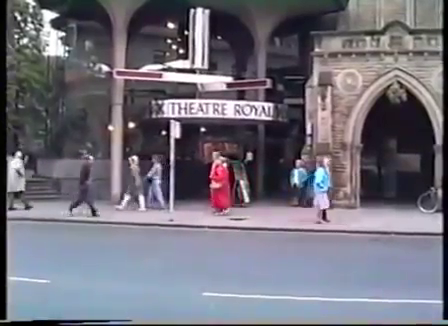
The theatre front. The Theatre Royal exterior has barely changed over the past 35 years.

A bus alighting at the St Leonard’s Place bus stop. The terrace to the right was initially built as housing stock however, by 1988, they would have housed various elements of York City Council. York City Council vacated these buildings in 2013 at which point they were refurbished and returned to use as housing.

Traffic. This too occurs in 2023.
Exhibition Square

The Art Gallery to the east of Exhibition Square. The area in front of the fountain remains an important bus stop for central York. The statue overlooking the fountain is of William Etty and was last restored in 2018.
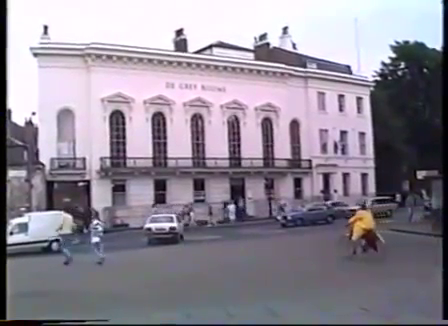
The De Grey Rooms. Build in the mid 19th century as an Officers Mess for the Yorkshire Hussars, by the 80s it had become part of York’s Tourist Information infrastructure.

A bus passing Bootham Bar.
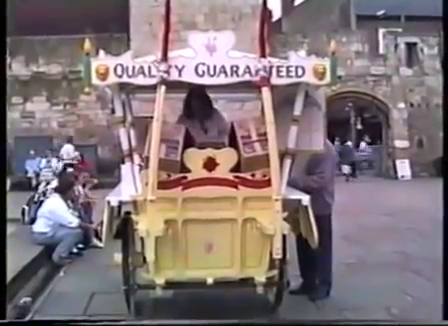
Street traders by the fountain in Exhibition Square.
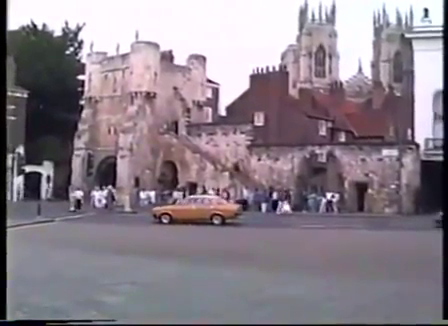
Bootham Bar with the Minster in the background. After passing through the Bar you would emerge onto High Petergate.
Lendal Bridge

North towards Scarborough Bridge. Just to the right was the old Museum Gardens toilet block, later closed and knocked down during the construction of The Star in the City. At this point in time the Museum Gardens would have also contained a troop of free roaming peacocks.
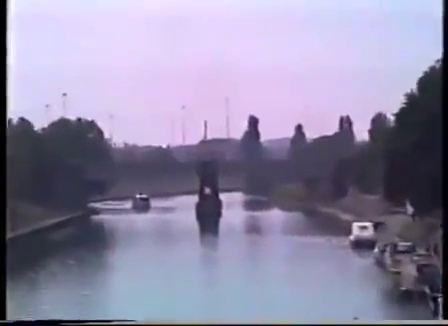
Scarborough Bridge. The just-visible public footpath that ran parallel to the railway bridge was demolished and replaced in 2019 by something much better suited to the needs of that part of the city.
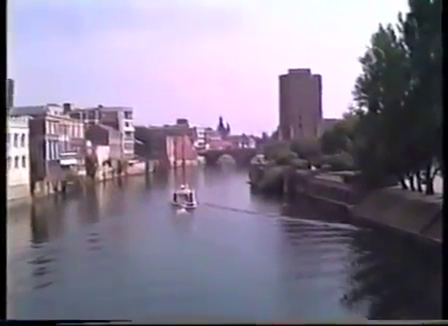
South towards Ouse Bridge. To the right, just before the tower of the hotel, is North Street Gardens. In 2017 a monument dedicated to the epidemiologist John Snow was unveiled. At one point this was also viewed as the possible site of a Roman Bridge.
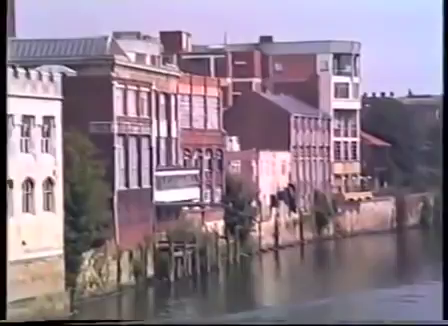
The Yorkshire Herald printing press building. Between 1997 and 2000 this was replace with what is now the City Screen Cinema.
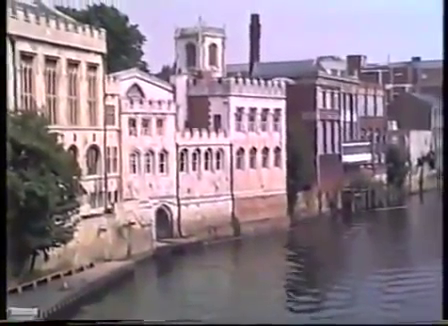
The Guildhall. Then home to the City of York council chambers, recently renovated and now part of the University of York. At water level in the centre is what is possibly an old water gate.
Station Road (I)
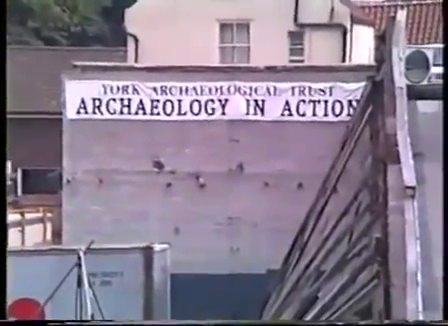
York Archaeological Trust banner at the dig on the corner of Tanner’s Moat and Wellington Row as seen from the Lendal Bridge rise on Station Road. Prior to the Trust’s excavation, this was the site of Leedhem’s Garage and the Armstrong Oiler – brief footage of which can be seen in Tours of Old York #1: 70s York in Flood.
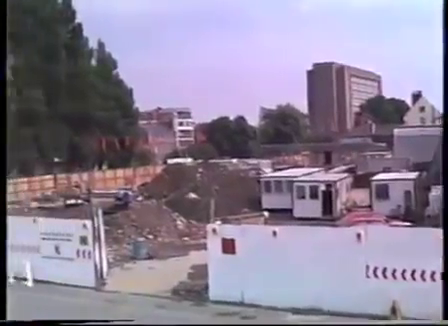
The Trust was given the opportunity to dig the area prior to the construction of a hotel for the Stakis group. Th hotel project would eventually be cancelled and the currently standing Aviva building would be built in it’s place.
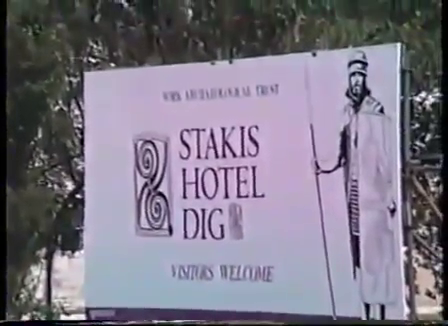
Hoarding advertising the dig.
York Railway Station
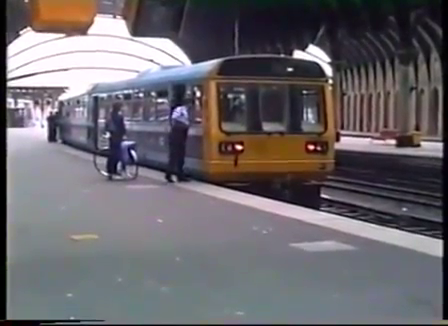
A Pacer waits on what is now platform 3 of York Station.
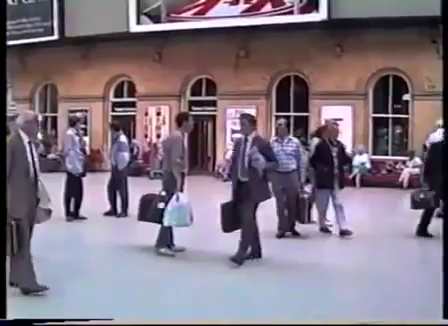
The track-side of the ticket office. In the modern station this area now contains a departure board. Above is an advertising hoarding for KitKat which, in 1988, would have been produced at the Rowntree’s Factory less than two miles away.
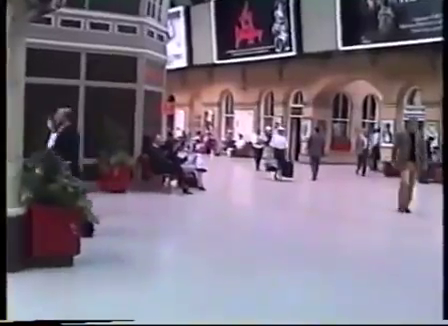
More of the concourse near the ticket office. There is also an advertising hoarding fYork Dungeon which, having opened in 1986, was something of a new addition to the city.
Station Road (II)
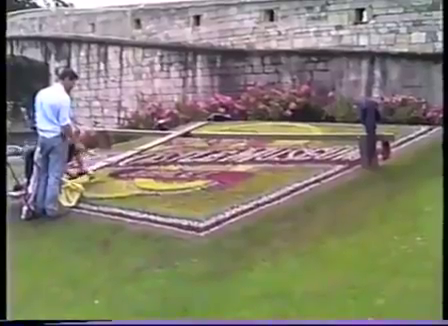
And back to Station Road and the rise to Lendal Bridge.

This patch of flowerbed still exists (see StreetView below), however, in 1988 it was planted in celebration of the Castle Museum‘s Golden Jubilee.
St. Helen’s Square
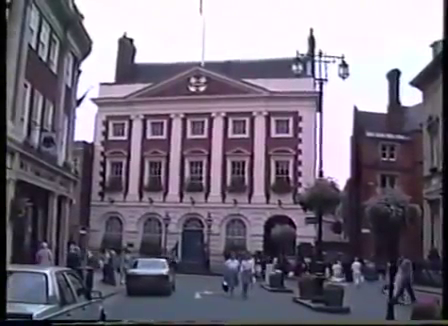
The historic home for York’s Lord Mayors, York Mansion House was the first building pose build for a Lord Mayor’s use in the UK. It is now run by York Museum’s Trust as a museum.

The York County Savings Bank Building which, by 1988, had passed into the hands of the TSB who, in various guises, would operate it as a bank until 2015. Outside sits Les Richardson who sold copies of the Evening Press from this pitch for almost 70 years. Richardson received an MBE in 1999 and died in 2003.
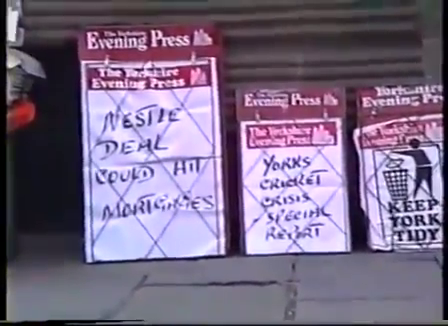
The evening’s headlines.
Coney St/New Street
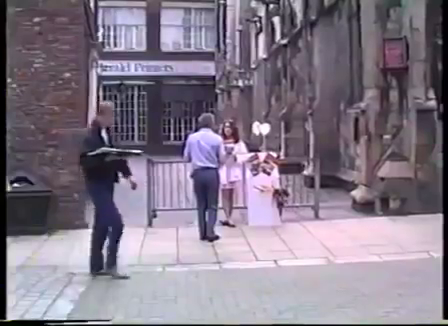
An alleyway off Coney Street by St Martin le Grand church. Down the alleyway lies the east side Yorkshire Herald printing press building, the west side of which we were able to see from Lendal Bridge. In 2023, this view would be of the river and of the City Screen cinema.
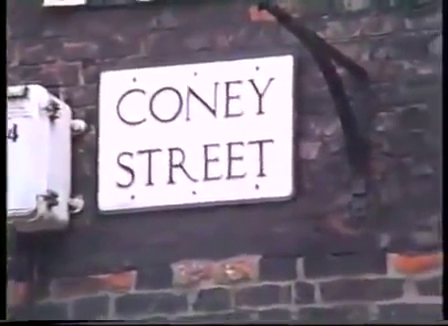
The Coney Street sign opposite New Street.
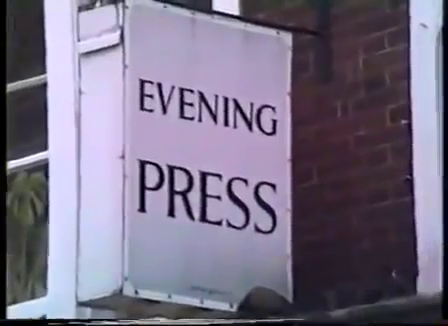
The Evening Press sign on the Press building..
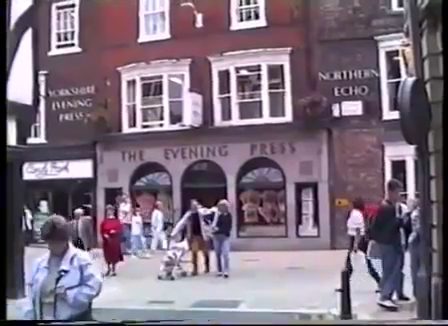
The Yorkshire Evening Press building in Coney Street. By the end of 1988 a replacement base for the Yorkshire Evening Press would be under construction on Walmgate. The Press would abandon this location and move shortly after it’s completion. Eventually, 15 Coney Street would house a Virgin Megastore and, then later on, a Waterstones Bookshop that remains there to this day.
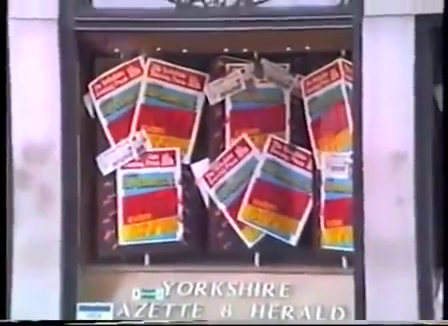
Posters in one of the Evening Press ground floor windows.
When?
This video was most likely shot in the middle of April 1988 – and there is a reasonable amount of evidence of this:
- The Castle Museum Flower Bed

York’s Castle Museum originally opened on the 23rd April 1938. This flowerbed – celebrating the Castle Museum’s golden (50th) jubilee – is in the middle of being planted. It is unlikely that they would plant a flowerbed after the celebration.
2. Nestle Deal Headline

On the 13th of April Joseph Rowntree’s was subject to the early stages of a hostile takeover. In an attempt to counter this, Rowntree’s sold itself to the Nestle group. This headline suggests that our video was filmed around this period of uncertainty.
Assuming that the video was shot during a single day (and the uniform grey sky suggests that it was), then it’s reasonable to suggest that our video was shot after the 13th of April but before the 23rd of April 1988.